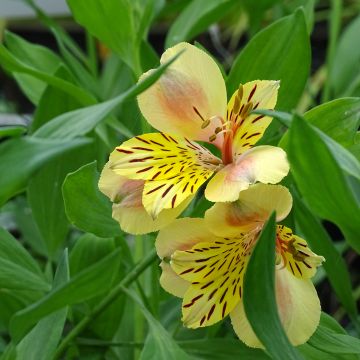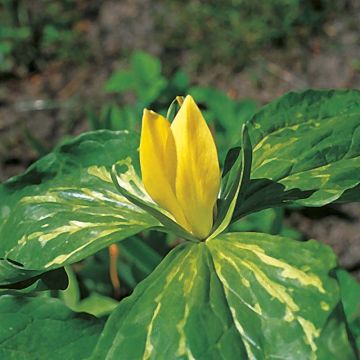

Lilium Mix - Lily
Lilium Mix - Lily
Lilium Mix
Lily
Bulbs received perfectly packaged, but due to the very wet weather. I was afraid it might be too late, but luckily the 6 lilies have started to sprout. Now I just have to wait for them to bloom :)
Féli, 16/05/2023
Special offer!
Receive a €20 voucher for any order over €90 (excluding delivery costs, credit notes, and plastic-free options)!
1- Add your favorite plants to your cart.
2- Once you have reached €90, confirm your order (you can even choose the delivery date!).
3- As soon as your order is shipped, you will receive an email containing your voucher code, valid for 3 months (90 days).
Your voucher is unique and can only be used once, for any order with a minimum value of €20, excluding delivery costs.
Can be combined with other current offers, non-divisible and non-refundable.
Home or relay delivery (depending on size and destination)
Schedule delivery date,
and select date in basket
This plant carries a 6 months recovery warranty
More information
We guarantee the quality of our plants for a full growing cycle, and will replace at our expense any plant that fails to recover under normal climatic and planting conditions.
Would this plant suit my garden?
Set up your Plantfit profile →
Description
This mix of oriental lilies brings together several varieties with large, pleasantly scented flowers of varied colours. Depending on the plants, they can be deep pink finely edged with white, mauve pink touched with orange at the throat, white speckled with pink, white with a pale yellow central line or white striped with pink-red. These easy-to-grow, vigorous lilies will faithfully flower in summer and can be planted in borders, pots or even large rockeries. These pretty flowers with sturdy stems are remarkable for cut flowers.
The Lillium genus belongs to the lily family, these are bulbous plants with deciduous foliage in a narrow and very vertical shape from spring onwards. Oriental hybrid lilies have been obtained through cross-breeding various species native to the Far East. Each plant will reach an average height of 90 cm (35in) when in flower, and the clump will spread indefinitely over time, as the bulbs produce bulblets through vegetative multiplication. In July and August, umbels of trumpet-shaped flowers composed of 6 wavy-edged petals, 12 to 15 cm (5 to 6in) in diameter with a sumptuous fragrance, will appear. The sturdy stems are covered in alternate, dark green, shiny and lanceolate leaves. The above-ground vegetation dries up in late autumn, marking the bulb's entry into dormancy.
Oriental lilies will thrive in soil rich with compost and do not like poorly drained, heavy soil. You can grow them with perennial plants as they prefer to have their feet in the shade and the other plants will help prevent the stems from bending in the wind. They also grow well in pots on the terrace, near entrances or in high-traffic areas to enjoy their elegant and fragrant flowers up close. These lilies will create chic and romantic bouquets, with roses and baby's breath, for example.
Report an error about the product description
Lilium Mix - Lily in pictures


Plant habit
Flowering
Foliage
Botanical data
Lilium
Mix
Liliaceae
Lily
Cultivar or hybrid
Other Lilies
View all →Planting and care
Oriental lilies do not like chalky, poorly drained and heavy, clay soils. Plant in full sun, with the base in the shade, preferably in spring, burying the bulbs 15 cm (6in) deep in a pocket of soil mixed with leaf compost. Surround them with a layer of sand to prevent rot and slug attacks, while allowing them to grow more easily. Mark the planting location, as vegetation only starts in April. Stake them when the stems reach 30 cm (12in) high. If red lily beetles appear, treat them immediately as their larvae can devour all the leaves. The most effective method is to catch them manually but be careful as they drop as soon as they are touched.
After flowering, it is a good idea to cut the faded flowers halfway up so that the bed remains beautiful during summer.
Tip for planting lilies in compact soil: The scaly bulbs of tall lilies are sensitive to clay soils that suffocate them and cause rot. In Eastern Europe, the following technique is used to help these bulbs survive the winter. Plant them on 'benches' built above ground level. These benches are made up of a layer of gravel, on which tightly packed branches are placed. Then cover everything with a thick layer of compost, 20 to 30 cm (8 to 12in) deep. Plant the bulbs in the compost, on which some ground-covering plants can also be grown. On the terrace, you can create sumptuous pots with lilies. Choose a container that is large and deep enough (at least 16 cm (6in) in diameter for 1 bulb). Fill it with a mixture of leaf compost and sand. Plant the lilies in groups of 3 to 5 bulbs, at a distance of 10-15 cm (4-6in), then water generously. Place the pots in a cool room, or outside once the frosts have passed. The room temperature should be around 12 °C. When shoots appear, move the pot to a conservatory or a very bright room, at a temperature of around 18 °C. Apply liquid fertiliser twice a month until the flower buds appear.
Planting period
Intended location
Care
-
, onOrder confirmed
Reply from on Promesse de fleurs
Similar products
Haven't found what you were looking for?
Hardiness is the lowest winter temperature a plant can endure without suffering serious damage or even dying. However, hardiness is affected by location (a sheltered area, such as a patio), protection (winter cover) and soil type (hardiness is improved by well-drained soil).

Photo Sharing Terms & Conditions
In order to encourage gardeners to interact and share their experiences, Promesse de fleurs offers various media enabling content to be uploaded onto its Site - in particular via the ‘Photo sharing’ module.
The User agrees to refrain from:
- Posting any content that is illegal, prejudicial, insulting, racist, inciteful to hatred, revisionist, contrary to public decency, that infringes on privacy or on the privacy rights of third parties, in particular the publicity rights of persons and goods, intellectual property rights, or the right to privacy.
- Submitting content on behalf of a third party;
- Impersonate the identity of a third party and/or publish any personal information about a third party;
In general, the User undertakes to refrain from any unethical behaviour.
All Content (in particular text, comments, files, images, photos, videos, creative works, etc.), which may be subject to property or intellectual property rights, image or other private rights, shall remain the property of the User, subject to the limited rights granted by the terms of the licence granted by Promesse de fleurs as stated below. Users are at liberty to publish or not to publish such Content on the Site, notably via the ‘Photo Sharing’ facility, and accept that this Content shall be made public and freely accessible, notably on the Internet.
Users further acknowledge, undertake to have ,and guarantee that they hold all necessary rights and permissions to publish such material on the Site, in particular with regard to the legislation in force pertaining to any privacy, property, intellectual property, image, or contractual rights, or rights of any other nature. By publishing such Content on the Site, Users acknowledge accepting full liability as publishers of the Content within the meaning of the law, and grant Promesse de fleurs, free of charge, an inclusive, worldwide licence for the said Content for the entire duration of its publication, including all reproduction, representation, up/downloading, displaying, performing, transmission, and storage rights.
Users also grant permission for their name to be linked to the Content and accept that this link may not always be made available.
By engaging in posting material, Users consent to their Content becoming automatically accessible on the Internet, in particular on other sites and/or blogs and/or web pages of the Promesse de fleurs site, including in particular social pages and the Promesse de fleurs catalogue.
Users may secure the removal of entrusted content free of charge by issuing a simple request via our contact form.
The flowering period indicated on our website applies to countries and regions located in USDA zone 8 (France, the United Kingdom, Ireland, the Netherlands, etc.)
It will vary according to where you live:
- In zones 9 to 10 (Italy, Spain, Greece, etc.), flowering will occur about 2 to 4 weeks earlier.
- In zones 6 to 7 (Germany, Poland, Slovenia, and lower mountainous regions), flowering will be delayed by 2 to 3 weeks.
- In zone 5 (Central Europe, Scandinavia), blooming will be delayed by 3 to 5 weeks.
In temperate climates, pruning of spring-flowering shrubs (forsythia, spireas, etc.) should be done just after flowering.
Pruning of summer-flowering shrubs (Indian Lilac, Perovskia, etc.) can be done in winter or spring.
In cold regions as well as with frost-sensitive plants, avoid pruning too early when severe frosts may still occur.
The planting period indicated on our website applies to countries and regions located in USDA zone 8 (France, United Kingdom, Ireland, Netherlands).
It will vary according to where you live:
- In Mediterranean zones (Marseille, Madrid, Milan, etc.), autumn and winter are the best planting periods.
- In continental zones (Strasbourg, Munich, Vienna, etc.), delay planting by 2 to 3 weeks in spring and bring it forward by 2 to 4 weeks in autumn.
- In mountainous regions (the Alps, Pyrenees, Carpathians, etc.), it is best to plant in late spring (May-June) or late summer (August-September).
The harvesting period indicated on our website applies to countries and regions in USDA zone 8 (France, England, Ireland, the Netherlands).
In colder areas (Scandinavia, Poland, Austria...) fruit and vegetable harvests are likely to be delayed by 3-4 weeks.
In warmer areas (Italy, Spain, Greece, etc.), harvesting will probably take place earlier, depending on weather conditions.
The sowing periods indicated on our website apply to countries and regions within USDA Zone 8 (France, UK, Ireland, Netherlands).
In colder areas (Scandinavia, Poland, Austria...), delay any outdoor sowing by 3-4 weeks, or sow under glass.
In warmer climes (Italy, Spain, Greece, etc.), bring outdoor sowing forward by a few weeks.










































